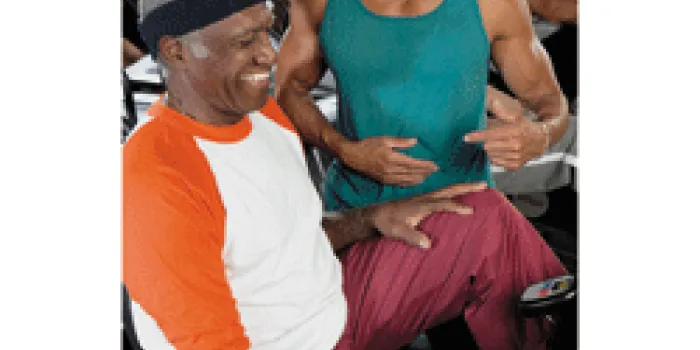“Muscle chisel” is an all-guy workout class that encourages men with bleeding disorders to focus on fitness. It’s a chance to sweat, socialize, have fun and learn how to exercise safely.
“The class gets me together with others who have faced issues around hemophilia,” says Barry Haarde, 48, a cross-country cyclist and computer technician with severe hemophilia A from Woodlands, Texas. “For me, the connection with others is the No. 1 thing about the class.”
And for people with bleeding disorders, exercise is essential. Not only does it improve your cardiovascular health and build muscle, it also strengthens joints and helps prevent bleeds.
The class participants, who range in age from 18 to 60, follow along as a trainer guides them through drills modified to accommodate their individual abilities. They lift weights, practice noncontact boxing moves and other low-impact cardiovascular exercises, and work their core muscles. These moves are performed to the sounds of classic soul, Michael Jackson, Katy Perry and other high-energy music. All the exercises are specially selected to appeal to guys.
Texas roots
For the past three years, muscle chisel classes have been held annually at the Texas Bleeding Disorders Conference, organized by the National Hemophilia Foundation’s (NHF’s) Lone Star Chapter. The class is financially supported by the Blood Brotherhood Program, a partnership between the Lone Star Chapter and Hemophilia Federation of America.
Muscle chisel has captured a loyal following. The average attendance has been about 15 men. “This class has had the highest number of participants of any we’ve offered to the Blood Brothers,” says physical therapist Donna Oldfield, PT, at the Gulf States Hemophilia and Thrombophilia Treatment Center (GSHTC) in Houston, where the classes were first created. She was one of the presenters of an hour-long muscle chisel session at NHF’s 65th Annual Meeting in Anaheim, California, in October 2013.
Sabrina Farina, LMSW, GSHTC site coordinator for the Lone Star Chapter’s Blood Brotherhood Program, first conceived of muscle chisel while working out at her own gym. She started pondering the possibility of offering something comparable for patients with bleeding disorders at the HTC. Farina and Oldfield invited James Loomis, a certified trainer at the University of Texas Health Recreation Center in Houston, to help design a program.
“James took bits and pieces of the various classes he teaches and modified them so that the cardio and weight training were lower impact,” says Oldfield. “He gave us a more gentle approach.”
The classes avoid exercises like deep squats, lunges and jumps, which are especially difficult for people with knee and other joint problems. They do include lots of equipment, though. The men work out with dumbbells, elastic resistance bands, barbells and Pilates balls in a variety of weights. Loomis leads the men through each exercise during the 60-minute class. Oldfield walks around, helping anyone who has difficulty with a particular move. For participants in wheelchairs, for example, she shows them how to work their arm muscles.
Male bonding
Because of their bleeding disorders, many men in the class have never participated in sports or fitness activities traditionally geared toward men. The slower, modified exercises in the muscle chisel class give them that opportunity. “For guys who haven’t exercised in a long time, it’s a great first step to taking up physical activity,” says Haarde.

